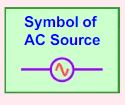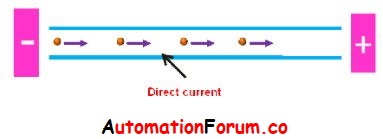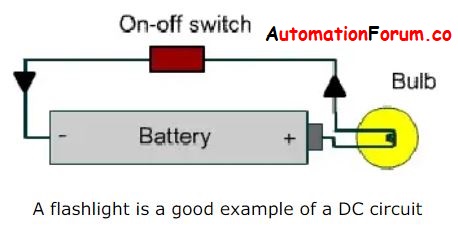What is Alternating Current?
Alternating Current, abbreviated as AC, is a type of electric current in which the electric charge periodically reverses direction to create alternately positive and negative values with the same magnitude.
The voltage rises smoothly from zero to the highest possible positive peak voltage in the alternating current’s sine waveform. Once it hits the negative peak value, which is equal to the positive in magnitude but different in polarity, it reverses course and sinks through zero into the other direction. To complete a cycle, the voltage reverses once more and increases as it approaches zero. At either the 50 HZ or 60 HZ’s rated frequency, this operation is repeated in cycle per second.
In contrast to direct current (DC), which only travels in one direction and cannot sporadically shift, alternating current (AC) is an electric current that periodically reverses direction.

- Hydro,
- Diesel,
- Steam, and
- Wind turbines
are used to produce the alternating current. Owing to its efficiency in generation and distribution, alternating current is the most widely used source of electrical power. Any necessary voltage level can be easily accommodated by stepping up and down the alternating voltage. The electrical power is transmitted at high voltages and low currents to reduce power losses in the conductors. This is later reduced back to meet the needs of the consumer at the distribution and consumer level.

Applications of Alternating Current:
- AC outlets are virtually always utilised in homes and offices. This is because it is extremely simple to generate and carry AC over vast distances. Less energy is lost in the transmission of electrical power at high voltages like those exceeding 110kV. Higher voltages result in lower currents, and lower currents result in less heat being produced by resistance in the power line. Transformers make it simple to convert high voltages to AC.
- Electric motors can also be driven by AC. The only difference between a motor and a generator is that a motor changes electrical energy into mechanical energy.
- Alternating Current is beneficial for many big, AC-powered equipment like refrigerators, dishwashers, Air conditioners, Washing machines, Iron boxes etc. and heavy load equipment.
What is Direct current?
The current that maintains both magnitude and direction constancy is known as a direct current, or DC. A DC current typically only has positive magnitude and a single-directional waveform. Due to its constant magnitude and direction, the DC waveform is a straight line. The DC waveform’s straight line is created through the smoothing process. This smoothing procedure makes use of an electrolyte capacitor. When the circuit is active, the capacitor stores/receives charge and releases it when the circuit is shut off.
Direct current (DC) is the continuous flow of the same amount of current in the same direction at the same intensity for at least one second via a conductor. Galvanic current or continuous current are two other names for direct current.

Applications of Direct Current:
- Every electronic application uses DC power. DC is required by anything that draws power from a battery, an AC adapter plugged into the wall, or a USB cable. DC electronics examples include:
Mobile phones
Flashlights
LED televisions
Electric and hybrid vehicles

- The most frequent sources of DC power include thermocouples, solar cells, and batteries. In low voltage applications like battery charging, automotive and aerospace systems, as well as other low voltage, low current applications, DC power is frequently used.
- DC power is now generated by all solar panels. Portable solar power systems and other off-grid equipment are typical DC power uses in the PV business. Costs for such systems will be kept low by not utilising a solar inverter to convert DC to AC.
Why AC current is used in Home appliances instead of DC?
There are many factors are considered to use AC in home appliances instead of using DC. They are as follows:
- Since the power plant from which our homes receive their electricity is located relatively far away, there are significantly fewer transmission losses for ac power than for dc power. With the use of transformers, ac power may be transported over great distances and changed effortlessly.
- As ac is alternating current and voltage, it has a frequency that makes it simple to manage any device. For example, variable frequency drivers make it simple to adjust the speed of motors, as well as the intensity of lights and other devices.
- Our household appliances are primarily inductive loads such as motors, iron boxes, fans, mixers, pumps, etc.
- Since dc generator maintenance is more expensive, producing ac power is more cost-effective. DC will result in higher per-unit costs and more losses.
- DC is riskier than AC from a safety standpoint.
- AC has lower production and transmission costs. AC can be easily regulated.
- Electronic equipment, for instance, requires DC at different voltages, and appliances in the home need AC (motors are simpler and more reliable on AC).
It has been proven throughout time that AC voltage creates effectively. The results of fully converting to DC power are unknown from an economic and practical standpoint because not enough equipment is currently configured to operate with DC voltage for it to become common practise. While AC voltage continues to offer the simplest, most dependable electricity that enables people to get through their days with ease, DC voltage is rapidly revealing its inefficiency in giving power across greater distances.
Some Useful Questions:
1. State Ohm’s law
According to Ohm’s Law, the current (I) flowing in an electrical circuit is directly is directly proportional to the applied voltage (V) and inversely proportional to the equivalent resistance (R)

2. What is Current?
The movement of electrical charge carriers like electrons is known as current. From negative to positive points, current flows. The ampere is the SI unit used to measure electric current (A). One coulomb of electrical charge travelling across a certain place in one second is referred to as one ampere of current. Appliances in the home and industry frequently use electric current.
3. What is the difference between AC and DC?
Alternating current (AC) | Direct current (DC) |
|---|---|
| Alternating current travels in both directions inside a circuit (sinusoidal) | Direct current only flows in one direction in a circuit. |
| A standard frequency for alternating current exists (50Hz) | No frequency exists in direct current. |
| Alternating current may travel great distances. | Long distances cannot be covered by direct current transmission. |
| Line losses exist in AC | No line losses exist in DC. |
| Transformers make it simple to step up and step down AC. | DC allows for the transmission of steady current. |





